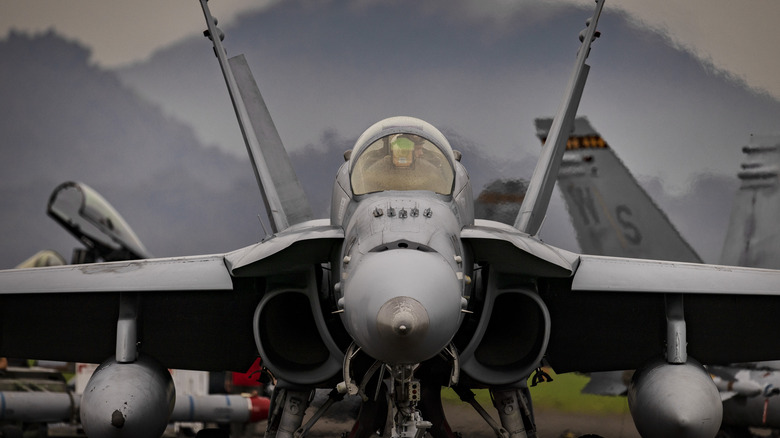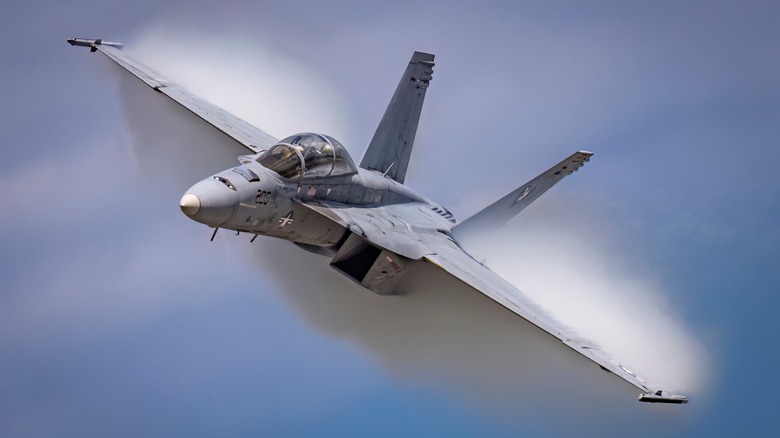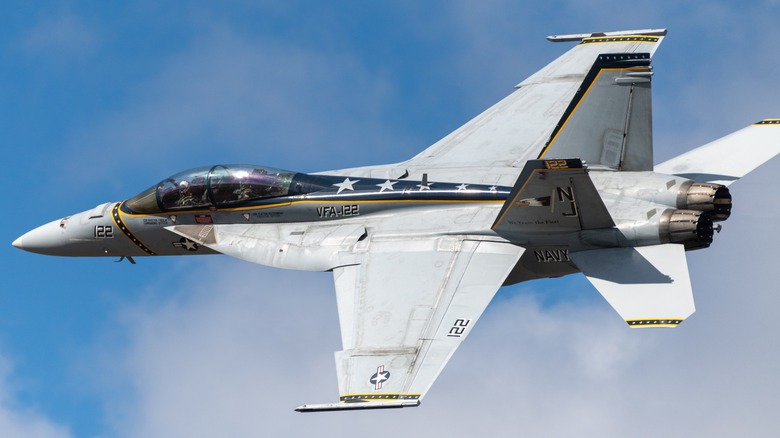Why The New F/A-18 Block III Super Hornet Is The Navy's Next-Level Fighter
The F/A-18 Hornet has long been one of the U.S. Navy's most powerful all-weather, carrier-capable, multirole combat aircraft. The F/A-18 entered active service in 1983 for the U.S. Marine Corps, and made its Navy debut the following year. Since then, the F/A-18 has been a mainstay of aircraft carrier operations around the world, and the aircraft has taken part in American conflicts since first entering combat during Operation El Dorado Canyon, which was the 1986 bombing of Libya.
Like other fourth-generation fighters, the F/A-18 is relatively old. It's decades older than fifth-generation aircraft like the F-22 and F-35, so one might wonder why it's still in operation. The simple answer is that the current model of the F/A-18 is vastly different from the aircraft first introduced by McDonnell Douglas, which constructed the F/A-18 alongside Northrop, beginning in the late 1970s to the 1990s.
The current F/A-18 is built by Boeing, and it's a far cry from the original aircraft. Recently, the U.S. Navy and Boeing introduced the F/A-18 Block III Super Hornet, which National Interest called the "unstoppable Navy fighter." This isn't merely an upgrade of an existing airframe; it's a complete overhaul that brought the F/A-18 from the 1970s and '80s into the 2020s, and the new variant will likely dominate U.S. aircraft carrier operations for the foreseeable future.
F/A-18 Block III Super Hornet's updated specifications
Looking at the F/A-18 Block III Super Hornet from the outside, you wouldn't notice anything different from its Block II predecessor. Since its introduction, multiple upgrades and variants have produced a variety of F/A-18s, with the Block II entering the inventory in 2005, so it's been nearly two decades since the aircraft received a significant upgrade. While Block III looks very much like Block II, the changes that matter are all on the inside.
The Block III features conformal fuel tanks, which attach to the fuselage instead of under the wing or belly pylons. This reduces drag significantly and makes it possible for the Block III to carry an additional 3,500 pounds of fuel. This extends the Block IIIs range, making it an ideal fighter for a possible conflict with nations with more advanced military jets. Additionally, the Block III's lifespan is extended from 6,000 hours to 10,000, making it ideal for training and combat operations.
Older F/A-18 models featured a four-screen interface, which has been replaced on the Block III with a new 10 x 19-inch customizable touch screen. The new display improves the aircraft's processing power by 17 times while enabling it to work with the Distributed Targeting Processor-Networked (DTP-N) MC. On top of that, further software upgrades won't require any hardware modifications, which is a huge improvement over legacy systems. Finally, the Block III incorporates a reduced radar cross-section.
What does all of this mean?
While upgraded fighters are always great to have, some may wonder why the U.S. Navy bothers to upgrade a fourth-generation fighter when newer fifth-generation fighters are available. It's true that there are more capable stealth aircraft being produced for a variety of missions, but that doesn't make the F/A-18 Super Hornet obsolete. It remains a fully mission-capable fighter with a proven track record that goes back decades.
Still, why not replace the F/A-18 with the F-35 Lightning II or something similar? The simplest answer is found in the numbers. Since its introduction, more than 1,400 F/A-18s have been produced. The F-35C Lightning II is the only aircraft carrier-capable fifth-generation fighter in operation today, though while 1,000 F-35s have been produced as of January 2024, only around 50 F-35Cs have rolled off assembly lines.
Looking at that, it's a simple numbers game, so the U.S. military won't replace all of its fourth-generation fighters until newer aircraft are produced to replace them. While Boeing plans to cease U.S. production in 2025, the company will continue producing them for foreign contracts. Regarding the aircraft's continued use in the U.S. military, with the introduction of the Block III, it's unlikely the fighter will go away anytime soon, as it remains a mainstay of U.S. Navy aircraft carrier operations around the world.


